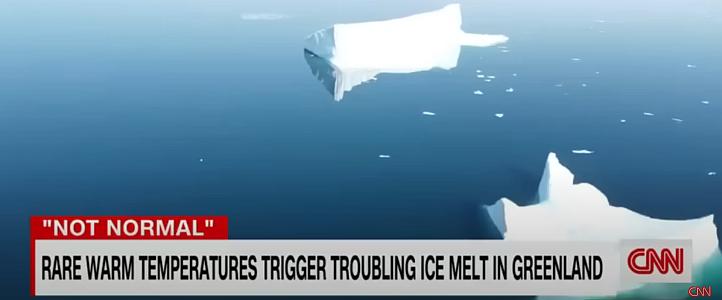 As record-breaking heat waves have sent temperatures soaring across Western Europe and parts of North America, unusually warm weather in Greenland has triggered massive melting of glacial ice. CNN reports that the amount of ice that melted in Greenland between July 15 and 17 alone – 6 billion tons of water per day – would be enough to fill 7.2 million Olympic-sized swimming pools, according to data from the US National Snow and Ice Data Center.
As record-breaking heat waves have sent temperatures soaring across Western Europe and parts of North America, unusually warm weather in Greenland has triggered massive melting of glacial ice. CNN reports that the amount of ice that melted in Greenland between July 15 and 17 alone – 6 billion tons of water per day – would be enough to fill 7.2 million Olympic-sized swimming pools, according to data from the US National Snow and Ice Data Center.
Put another way, it was enough to cover the entire area of the state of West Virginia with a foot of water.
“The northern melt this past week is not normal, looking at 30 to 40 years of climate averages,” said Ted Scambos, a senior research scientist at the National Snow and Ice Data Center at the University of Colorado. “But melting has been on the increase, and this event was a spike in melt.”
“It definitely worries me,” said Kutalmis Saylam, a research scientist with the University of Texas who is currently stationed in Greenland. “Yesterday we could wander around in our t-shirts – that was not really expected.”
Each summer, scientists worry that they will see a repeat of the record melting that occurred in 2019, when 532 billion tons of ice flowed out into the sea. An unexpectedly hot spring and a July heat wave that year caused almost the entire ice sheet’s surface to melt. Global sea level rose permanently by 1.5 millimeters as a result.
Greenland holds enough ice – if it all melted – to lift sea level by 7.5 meters around the world.
In 2020, scientists found that Greenland’s ice sheet had melted beyond the point of no return. No efforts to stave off global warming can stop it from eventually disintegrating, said researchers at The Ohio State University. The rate of melting in recent years exceeds anything Greenland has experienced in the last 12,000, another study found – and enough to cause a measurable change in the gravitational field over Greenland.
‘Deeply concerning to scientists’: Greenland’s ice is rapidly melting in warm weather

“Global sea level rose permanently by 1.5 millimeters as a result.”
Remarkable.
Holding one’s fingers apart approximately 1.5mm (or looking at that on a ruler) and then picturing the entire world ocean being so affected by a single summer’s melt is quite thought-provoking.
“…enough to cause a measurable change in the gravitational field over Greenland.”
Leading to another astounding fact: if/when/as Greenland loses enough ice mass, –local– sea level will actually drop. Even Iceland will get a bit of a free passfrom SLR from the effect.
Diagnostic feature of a mind blown by facts and big statistics: denial. 😉
The UK is still being affected by land rising after the loading of ice and glaciers over Scotland melted at the end of the last ice age. The south was not covered with ice so there is no bounce back.
Thus the north of the island is rising relative to sea level compared to the south.
Apparently!